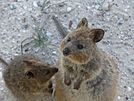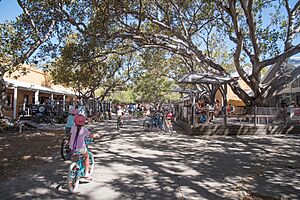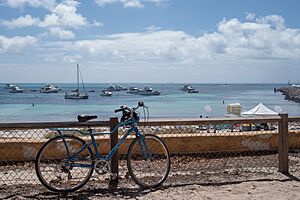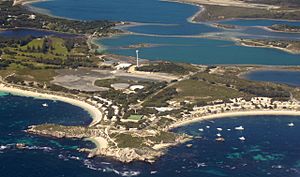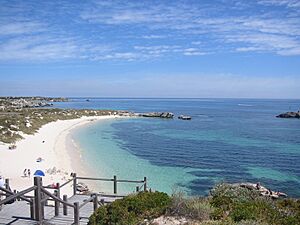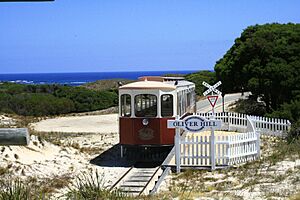Rottnest Island facts for kids
Quick facts for kids Rottnest IslandWestern Australia |
|||||||||
|---|---|---|---|---|---|---|---|---|---|
|
Clockwise from top: Rottnest Island from space; the Basin; Wadjemup Lighthouse, quokkas; and Parker Point
|
|||||||||
| Lua error in Module:Location_map at line 416: Malformed coordinates value. | |||||||||
| Postcode(s) | 6161 | ||||||||
| Elevation | 46 m (151 ft) | ||||||||
| Area | 19 km2 (7.3 sq mi) | ||||||||
| Time zone | AWST (UTC+8) | ||||||||
| Location | 18 km (11 mi) W of Fremantle | ||||||||
| LGA(s) | City of Cockburn | ||||||||
| State electorate(s) | Fremantle | ||||||||
| Federal Division(s) | Fremantle | ||||||||
|
|||||||||
Rottnest Island (also called Wadjemup by the Noongar people) is a special island off the coast of Western Australia. It's about 19 square kilometers in size and sits 18 kilometers west of Fremantle. This sandy island is a protected area, meaning its nature and history are kept safe.
Long ago, Rottnest Island was connected to the mainland. But about 7,000 years ago, sea levels rose, turning it into an island. The Noongar people call it Wadjemup, which means "place across the water where the spirits are." Ancient tools found here show people lived on the island at least 17,000 years ago.
In 1696, a Dutch captain named Willem de Vlamingh explored the island. He called it 't Eylandt 't Rottenest, meaning "Rats' Nest Island," because he saw many small, furry animals he thought were large rats. These animals were actually quokkas, which are now famous on the island!
Over the years, Rottnest Island has been used for different things. It was once a prison for Aboriginal people, a military base, and a place to hold people during wartime. Today, many old buildings are used for holiday accommodation.
Rottnest is famous for its friendly quokkas. It's also home to Australian sea lions, seals, and many birds. The island is a popular spot for tourists, with ferries arriving daily from Perth and Fremantle. About 300 people live there permanently, but around 780,000 visitors come each year!
Contents
Island History
Early Times and Ancient Life
Thousands of years ago, when sea levels were much lower, Rottnest Island was part of the mainland. It was like a big hill sticking up from the coastal plain. As the sea rose, Rottnest became separated from the mainland around 6,500 years ago.
Scientists have found stone tools on the island that show people lived here at least 17,000 years ago. These tools tell us about the early Aboriginal people who explored this land. The Noongar people have a special connection to Wadjemup, their traditional name for the island.
European Explorers Arrive
Many European explorers visited the island from the 1600s onwards. The first Europeans to land were Dutch sailors in 1658. They were looking for survivors from a shipwreck.
In 1696, Dutch captain Willem de Vlamingh spent six days exploring the island. He was amazed by its beauty, calling it "a paradise on earth." He also noticed the many quokkas, which he mistook for large rats, giving the island its name, "Rats' Nest Island."
A Difficult Past: The Aboriginal Prison
From 1838 to 1931, Rottnest Island was used as a prison for Aboriginal people. Over 3,600 Aboriginal men and boys were held there. They faced very harsh conditions and were forced to do hard labor, like farming and quarrying. Many of the island's historic buildings were built by these prisoners.
Sadly, at least 373 people died while imprisoned on the island. They were buried in unmarked graves. Today, this area is known as the Wadjemup Aboriginal Burial Ground. In recent years, efforts have been made to recognize this sad part of history and honor those who died.
Boys' Reformatory
A special school for boys, called a reformatory, opened on the island in 1881. It taught boys skills like carpentry and gardening. During a serious sickness in 1883, many people, including some boys, became ill. The reformatory closed in 1901.
Fires on the Island
Rottnest Island has experienced many bushfires over the years. Some were started by people, and one in 1955 burned about two-thirds of the island. These fires sometimes harmed the quokka population.
Wartime History
During both World War I and World War II, Rottnest Island was used as a holding place for people suspected of being enemies.
In World War II, the island became an important military site. Large guns were installed at Oliver Hill and Bickley Point to protect the port of Fremantle. A special railway was built to move supplies and ammunition to these guns. Today, you can take a train tour to see the old guns and tunnels at Oliver Hill!
How the Island is Managed
Rottnest Island is a special state reserve, managed by the Rottnest Island Authority. This group works to protect the island's environment and history, while also making it a great place for visitors.
COVID-19 Quarantine
In 2020, during the COVID-19 pandemic, Rottnest Island was used as a quarantine station. People arriving in Australia stayed there to make sure they were healthy before going to the mainland.
Amazing Animals and Plants
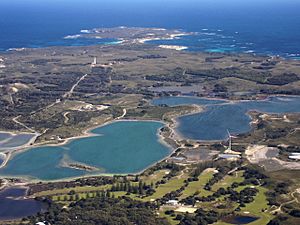
Rottnest Island is a fantastic place for nature lovers! It has many unique animals and plants.
Birds of Rottnest
Many different birds live on Rottnest Island. You can see coastal birds like the pied cormorant and osprey near the ocean. The island's salt lakes are home to birds like the red-necked avocet and banded stilt, who feed on tiny brine shrimp. Some osprey nests on the island are thought to be 70 years old!
Other Animals on the Island

The most famous animal on Rottnest is the quokka. These small, friendly marsupials are found in very few places, and Rottnest is one of their main homes. They are safe here because there are no natural predators like on the mainland.
You might also spot bottlenose dolphins swimming in the bays. Humpback whales and blue whales migrate past the island, and you can sometimes see them on whale-watching trips. There are also colonies of Australian sea lions and New Zealand fur seals living on nearby rocks.
The island has several types of reptiles, including snakes and lizards, and three kinds of frogs.
Plants of Rottnest

Rottnest has three native tree species: the Rottnest Island pine, the Rottnest Island teatree, and Acacia rostellifera. You can also find the pretty Rottnest Island daisy.
Long ago, the island had many more trees. But over time, farming, collecting firewood, and bushfires reduced the number of large trees. Now, there's a special program to plant more trees and help the island's environment recover.
Island Climate
Rottnest Island has a Mediterranean climate. This means it has warm, dry summers and mild, wet winters. Even in summer, it can feel a bit humid.
| Climate data for Rottnest Island | |||||||||||||
|---|---|---|---|---|---|---|---|---|---|---|---|---|---|
| Month | Jan | Feb | Mar | Apr | May | Jun | Jul | Aug | Sep | Oct | Nov | Dec | Year |
| Record high °C (°F) | 41.9 (107.4) |
41.5 (106.7) |
40.8 (105.4) |
35.2 (95.4) |
29.2 (84.6) |
24.9 (76.8) |
23.4 (74.1) |
28.3 (82.9) |
32.8 (91.0) |
36.4 (97.5) |
38.4 (101.1) |
42.5 (108.5) |
42.5 (108.5) |
| Mean maximum °C (°F) | 36.5 (97.7) |
36.1 (97.0) |
35.3 (95.5) |
30.4 (86.7) |
25.8 (78.4) |
22.3 (72.1) |
21.2 (70.2) |
21.6 (70.9) |
24.0 (75.2) |
28.8 (83.8) |
32.5 (90.5) |
35.3 (95.5) |
38.8 (101.8) |
| Mean daily maximum °C (°F) | 26.7 (80.1) |
27.3 (81.1) |
26.1 (79.0) |
23.8 (74.8) |
21.2 (70.2) |
18.8 (65.8) |
17.9 (64.2) |
18.0 (64.4) |
18.9 (66.0) |
20.6 (69.1) |
23.1 (73.6) |
25.3 (77.5) |
22.3 (72.1) |
| Mean daily minimum °C (°F) | 19.2 (66.6) |
19.5 (67.1) |
18.8 (65.8) |
17.3 (63.1) |
15.2 (59.4) |
13.4 (56.1) |
12.5 (54.5) |
12.4 (54.3) |
13.0 (55.4) |
14.1 (57.4) |
15.9 (60.6) |
17.8 (64.0) |
15.8 (60.4) |
| Mean minimum °C (°F) | 15.1 (59.2) |
15.3 (59.5) |
14.2 (57.6) |
13.1 (55.6) |
11.1 (52.0) |
9.9 (49.8) |
8.8 (47.8) |
8.7 (47.7) |
8.8 (47.8) |
10.0 (50.0) |
11.5 (52.7) |
13.4 (56.1) |
7.8 (46.0) |
| Record low °C (°F) | 11.3 (52.3) |
10.9 (51.6) |
9.5 (49.1) |
10.3 (50.5) |
8.8 (47.8) |
7.0 (44.6) |
6.6 (43.9) |
6.2 (43.2) |
6.7 (44.1) |
7.2 (45.0) |
6.6 (43.9) |
10.8 (51.4) |
6.2 (43.2) |
| Average rainfall mm (inches) | 13.7 (0.54) |
10.3 (0.41) |
18.4 (0.72) |
32.6 (1.28) |
70.2 (2.76) |
102.0 (4.02) |
111.9 (4.41) |
85.2 (3.35) |
51.0 (2.01) |
27.2 (1.07) |
18.7 (0.74) |
9.7 (0.38) |
553.4 (21.79) |
| Average precipitation days | 2.2 | 1.9 | 3.9 | 7.6 | 11.3 | 15.3 | 18.3 | 17.1 | 13.1 | 8.6 | 5.4 | 3.3 | 108.0 |
| Average afternoon relative humidity (%) (at 15:00) | 63 | 61 | 60 | 61 | 60 | 63 | 64 | 64 | 64 | 63 | 63 | 61 | 62 |
| Source: Bureau of Meteorology Temperatures and rain data: 1983–2020; Relative humidity: 1991–2010 |
|||||||||||||
Visiting Rottnest Island
Rottnest Island is a very popular place for holidays and day trips. Around 450,000 to 500,000 people visit each year! Most visitors come in the summer, especially in January.
Getting Around the Island
You won't find private cars on Rottnest Island. Only emergency and service vehicles are allowed. The best way to get around is by bicycle or by using the island's bus service. Many people bring their own bikes or rent one when they arrive.
Places to Stay and Eat
The main area for visitors is Thomson Bay. It's a sheltered bay perfect for swimming and boating. There are also smaller settlements at Geordie Bay and Longreach Bay.
You can find many places to stay, from villas and cottages to hotels. It's a good idea to book accommodation far in advance, especially for busy times.
In Thomson Bay, you'll find cafes, restaurants, a general store, and a bakery. Geordie Bay also has a general store and cafe.
Fun Activities on Rottnest
Rottnest Island offers lots of fun activities:
- Cycling: Explore the island's beautiful beaches and historic sites on two wheels.
- Swimming and Snorkeling: Enjoy the clear waters at places like The Basin and Parker Point. There's even an underwater trail with plaques to teach you about marine life!
- Diving: The island's reefs are great for diving, especially if you want to try catching crayfish (during the open season).
- Wreck Trail: Explore underwater shipwrecks with a glass-bottomed boat tour or by diving.
- Oliver Hill Railway: Take a train ride to see the old World War II guns and tunnels.
Special Events
Rottnest Island hosts several exciting events each year:
- Rottnest Channel Swim: A long-distance swimming race from Cottesloe Beach to Rottnest Island in February.
- Rottnest Marathon & Fun Run: Running events of different distances held in October.
- Rottofest: A festival of comedy, film, and music in September.
Getting to Rottnest Island
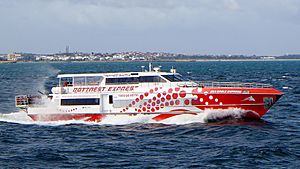
Most visitors travel to Rottnest by ferry. Ferries leave from Fremantle, Perth, and Hillarys. The trip takes about 25 minutes from Fremantle or 45-90 minutes from Perth or Hillarys. You can also fly to the island by helicopter or light plane.
Oliver Hill Railway
The Oliver Hill Railway was originally built during World War II to move military supplies. In 1993, it was rebuilt for tourists. Now, you can ride a special train, named the Captain Hussey, to visit the historic gun emplacements at Oliver Hill.
Island Services
Even though it's an island, Rottnest has important services. It gets its water from underground and also uses a special plant to turn seawater into fresh water.
The island uses a mix of diesel generators and a large wind turbine for its electricity. The wind turbine helps power about 37% of the island, saving a lot of fuel!
Rottnest is also very good at recycling. It was one of the first places in Western Australia to have a public recycling program.
Helping Out on Rottnest
Many volunteers help keep Rottnest Island beautiful. They do things like guided tours, planting trees, picking up litter, and building pathways. These groups help protect the island's environment and share its stories with visitors.
See also
 In Spanish: Isla de Rottnest para niños
In Spanish: Isla de Rottnest para niños





